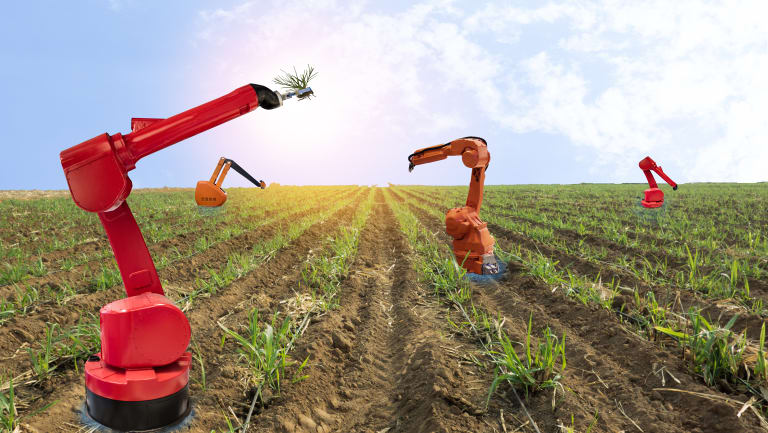Walking around a field of potatoes a thought came to mind: after picking the potatoes they will probably travel tens if not hundreds of miles to be cleaned and graded before returning to my local shop where I can by them - why can they not go straight to the shop?
Something needs to change if we are going to win the fight against climate change, improve our health and have more interesting work.
But how could it be done? First there needs to be enough land surrounding a village to support all of its households with food and other produce. Following guidance from the self sufficiency expert John Seymour, around one acre per household without cows or five acres with animals is needed. In the village where I live there are roughly five hundred households and therefore the land required would be about five hundred acres and it would be possible for local farmers to support the village.
To reduce the reliance on chemicals for increasing crop yields the emerging technology of robotics and AI could be used. The Small Robot Company, who are working with the National Trust, are developing robots that can plant, monitor and treat crops autonomously. Robots can harvest a variety of crops ranging from lettuces to raspberries. Once harvested there are different ways for processing the produce locally, for example it could be processed in shipping container type boxes which would either be situated on the farm or in the village. Shipping containers are already used in small bakeries such as the Docker Bakery in Folkestone. Milk could be pasteurised on the farm and containers could be used to house equipment for preserving surplus produce. Delivery of the produce to the customer would use robots similar to those used in Milton Keynes to deliver pizzas. Customers could register their daily purchases of the products via an app and the seasonal demand would be analysed using AI so that that the amount of annual planting would be optimised to reduce waste.
There would be many benefits for such a system. If the robots were powered via solar panels they would probably be much smaller than the large tractors that can be seen currently in the fields therefore field size could be reduced and hedge rows re-introduced which would improve biodiversity. Local jobs would be created to develop, build and and maintain the robotics and AI systems as well as growing and processing the produce. New skills would be required in developing technology such as 3D printing which would be used to replace parts on the robots. Old skills would be re-discovered such as pickling surplus produce or making containers from locally produced willow for the robots to transport the produce to the doorstep.
Of course there are a few problems with this vision. First there is what I have labeled the ‘avocado problem’ which is crops that we cannot produce in the UK because of our climate e.g. tea. Some form of trade will still be required. However with increasing breakthroughs in biotechnology there may be a way of growing avocados and other plants in the UK. Another aspect is the seasonality of the produce. Customers want strawberries all the year round but if the price for non-seasonal crops reflected the true cost, for example the impact on the environment of shipping them thousands of miles, then seasonality of home grown fruit and vegetables would become more financially attractive. Anyway I have found that strawberries being available only at certain times of the year makes them more delicious!
The vision is also based on a village or small town surrounded by fields but it would have to be developed in a different way for large towns or cities. Ideas such as ‘vertical’ farming and exciting projects carried out in Singapore which show that crops can be grown on carpark rooftops could be utilised. Producing mushrooms underground in a city shows that there is potential to grow food in large urban areas.
The long and complex supply chains that are used to bring food to our house are based on high carbon miles. They are also weak to disruption which have been highlighted during the Covid-19 pandemic. There are many advantages of locally produced food: significant reduction in carbon miles which will reduce global warming, fresh produce which will improve health, redesigning of farming systems will increase biodiversity, outdoor projects where the local community can get involved will improve mental as well as physical health, and more interesting jobs will give greater job satisfaction. Maybe one day potatoes picked that morning could only be a click away - now there is a thought.
